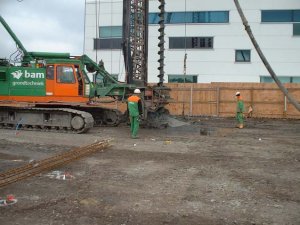 |
||
|
Guidance > Working Platforms > FPS Guide to Hydraulically Bound Platforms FPS Guide to Hydraulically Bound Platforms
Piling rigs are likely to become unstable on poorly designed platforms and on well designed platforms that are not rigorously managed by a maintenance and repair schedule. A working platform should provide a safe and sufficiently durable working surface from which construction plant, such as piling rigs and cranes can operate. The expression working platform in this guidance is restricted to ground supported working platforms, including not only the platform itself but also the associated ramps and accesses. This guidance covers the key issues related to working platforms constructed using stabilised materials. These comprise hydraulically bound materials (HBM), mixtures that set and harden by hydraulic reaction. They also include CBM (i.e. mixtures based on the fast setting and hardening characteristics of cement) and hydraulically bound mixtures based on slower setting and hardening binders made from industrial by-products such as PFA and blast furnace slag. Contractual arrangements should ensure that the platform is properly designed, installed, operated, maintained and, as necessary, repaired throughout its working life. The respective roles of the various parties should be clearly understood and the responsibilities and liabilities of all parties should be defined in the relevant contract. This guide does not extend or affect such responsibilities and liabilities. Installation, operation, maintenance and repair of the platform should ensure that it performs according to the design over its design life. Systems should be in place to ensure that;
The design of a temporary platform requires information about each load bearing soil layer. The subgrade is in general characterised by an undrained shear strength (cohesive, cu) or angle of shearing resistance (granular, f'); representative values should be identified for the areas of platform to be designed. Later applications for the working platform may require further information for design purposes. Whilst in general volume stability of a temporary platform will not be an issue, the sulphate content of soils to be treated may well need to be addressed if a permanent works design is also being considered. Site drainage requirements may vary throughout the year and the need for any additional drainage should be assessed and incorporated into the platform construction programme. Weather, particularly temperature, may adversely affect the setting of the HBM binder. Last minute project design changes can lead to changes in construction, and hence working platform levels. The potential implications of such changes, particularly when there is cut and fill on a site, should be recognised and the working platform designer informed. The design of a working platform is a geotechnical design process and should be carried out by a competent person. The designer should have full access to the health and safety plan, including the desk study and all other site investigation information. This guide is not intended to replace or reduce the designer's input, but rather to promote the implementation of minimum design, installation and maintenance standards. HBM materials are likely to have very low permeability. Hence drainage design is critical, to ensure that the platform remains suitable for use and does not become waterlogged, potentially creating plant instability and hazards to operatives. In general this can be carried out by careful construction of the platform layer and/or the subgrade. Falls can be constructed into the platform by means of grading during final compaction. Large areas may require falls to intermediate drains as plant stability necessitates a maximum gradient of 1 in 10. In all cases the requirements of the construction timescale should be taken into account. Winter working may require drainage design for heavier rainfalls and the water table beneath the platform may also rise. Similarly ice forming on the platform due to the presence of standing water can render construction activities dangerous. In the worst cases it may be necessary to place a granular topping layer. Due consideration must be given to the piling process employed. Some piling techniques will cause groundwater to be deposited on top of the platform and this quantity must be added to that from rainfall and any rising groundwater table. Also if the piling technique employs a support fluid then this must also be taken into account. Driven piling, whether precast or cast insitu will probably require pre-boring of pile positions prior to driving to minimise damage to the platform. Disclaimer: Although every effort has been made to check the accuracy of the information and validity of the guidance given in this document, neither the FPS or its members accept any responsibility for mis-statements contained herein or misunderstanding arising herefrom.
HBM Platform installed by O'Keefe Soil Remediation Ltd © O’Keefe Soil Remediation Ltd
|
Documents AvailableUse of 'Structural Geosynthetic Reinforcement' - a BRE review seven years on FPS Guide to Hydraulically Bound Platforms Working platform design sensitivity Calculation of track bearing pressures
|
|